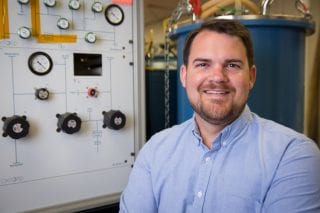Fulbright College Physicist Receives NSF CAREER Award for Nanowire Research
Physicist Hugh Churchill has received a Faculty Early Career Development Award of $545,241 from the National Science Foundation (NSF) to further his research on nanowires with electrical and magnetic properties that show promise in the next generation of digital technology, solar energy and quantum computing.
Commonly known as a CAREER award, the prestigious grant program supports early career faculty who have the potential to serve as academic role models in research and education. Faculty at the University of Arkansas received nine CAREER awards in 2018, ranking 15th in the nation.
Churchill, an assistant professor in the Department of Physics in the J. William Fulbright College of Arts and Sciences, is studying 100-nanometer-wide nanowires made up of spiraling chains of either selenium or tellurium.
The unique structure of these chains allows them to produce unusually large magnetic fields, which could be used for spintronics, or in technology powered by magnetic properties rather than electronics.
Selenium and tellurium also belong to a recently discovered category of materials called topological quantum materials, that have unique properties. Selenium and tellurium’s topological properties make them extremely good at carrying electricity, because electrons traveling through these materials behave as if they have no mass.
In addition, the topological characteristics of these materials could make them capable of producing a qubit — the basic element of quantum computing — which is extraordinarily stable.
 Churchill and his research team plan to combine their expertise in quantum devices and two-dimensional materials to study the electronic, magnetic and quantum topological characteristics of selenium and tellurium.
Churchill and his research team plan to combine their expertise in quantum devices and two-dimensional materials to study the electronic, magnetic and quantum topological characteristics of selenium and tellurium.
“It’s exciting to me that these elements have both been known for over 200 years, but now we are in a position to reveal their character as topological quantum materials,” Churchill. “Though this is a single investigator award, I benefit immensely from a larger team of physics and engineering faculty investigating these materials, as well as from the efforts of students whose work laid the foundation for this new project.”
The work in Churchill’s group is part of a broader research effort on campus investigating selenium and tellurium nanostructures that includes Greg Salamo, Jin Hu and Salvador Barraza-Lopez from the Department of Physics and Fisher Yu from the Department of Electrical Engineering.
For more information, visit the Churchill Lab online at http://churchill-lab.com.
A version of this story also appeared in the U of A’s Newswire publication and in its Research Frontiers blog.
Camilla Shumaker
Director of Science and Research Communication, University Relations
479-575-7422 // camillas@uark.edu


